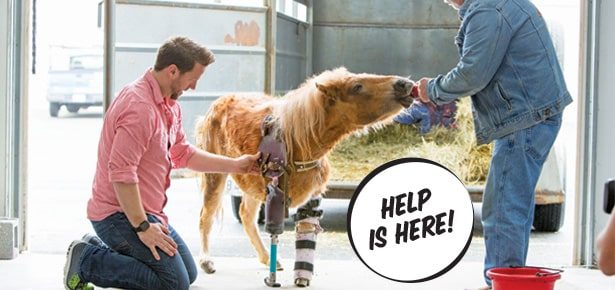
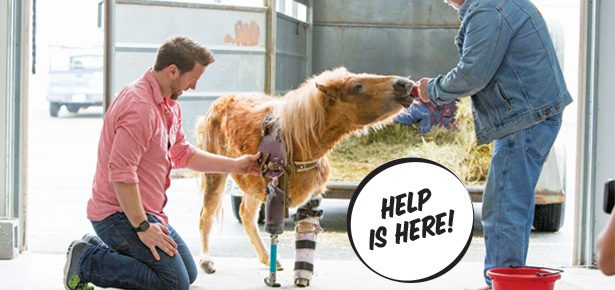
The Dr. Dolittle of Pet Prosthetics
From dogs to elephants, Derrick Campana is changing the lives of animals by specializing in a field of his own creation
When a veterinarian, desperate for help, brought a chocolate Lab to the human prosthetics and orthotics clinic where Derrick Campana worked 12 years ago, Derrick’s life was changed forever.
The dog, named Charles, needed a prosthetic leg due to a rare congenital deformity called ectrodactyly, which causes limbs to form abnormally. Serving animals was something Derrick had never considered, but he forged ahead nonetheless. After successfully creating a prosthetic leg on the first try, Derrick had a lightbulb moment.
“It opened my eyes to an entire field,” he says. “I knew I could do this for more animals.”
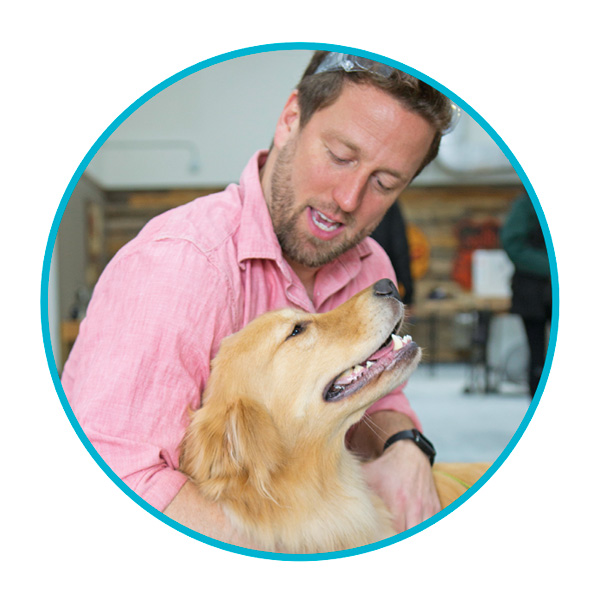
Still, the idea of combining two of his main interests—helping others and his love of animals—was too good to pass up.
In short order, he founded Animal Ortho Care in Stirling, Virginia, and now works with specialty and holistic veterinarians to create orthotics and prosthetics to help animals with limbs disabled through trauma, illness or old age.
At this point in the story, a joke could be inserted about giving these animals a new “leash” on life, but in Derrick’s case, it’s true.
Thanks to his groundbreaking work, orthotics and prosthetics are on their way to becoming commonplace in the animal world, saving tens of thousands of lives and making the 38-year-old animal orthotist and prosthetist one of the world’s few experts in the field.
Since founding his company 12 years ago, Derrick has created an average of 1,000 prosthetics a year. He’s treated between 15,000 and 20,000 animals, including miniature horses, bald eagles, turtles, goats, sheep, deer, llamas, and a gazelle. It’s earned him the nickname of the Dr. Dolittle of Pet Prosthetics, something that makes him chuckle. Derrick has travelled to Spain to treat a ram and to Lampang, Thailand to fit two elephants who lost their legs in land mine explosions while crossing the Burmese border. “I took these casts home, made check sockets, and sent them to Thailand where the Thai prosthetists fabricated the rest of the prosthetic devices,” he says. But for all his work with exotic animals, he estimates that 90 percent of his patients are dogs.
One of the big differences between working in human prosthetics versus animal prosthetics is the materials. Because there are no insurance bodies dictating what materials must be used on animals, “I can use the materials I think will work just right,” Derrick says.
His material of choice is medical-grade plastics—both traditional high-temperature thermoformable plastic and low-temperature thermoplastics—ideal materials for prosthetics and orthotics because they are durable and can be form fit to the individual animal. Its versatility allows Derrick to custom-build prosthetic devices to meet the unique needs of each animal under his care. Easily mouldable, the prosthetics can be easily reshaped as an animal grows—helping reduce costs and thereby making these life-changing mobility devices available to more animal owners.
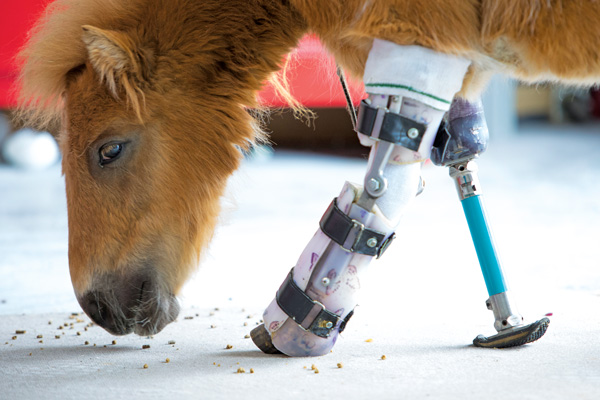
“It’s really cool that people are putting money into advancing this field,” Derrick says. “We’re giving animals the same treatment options as humans.”
To make the prosthetics, he uses casting kits 95 percent of the time, but technology has made his job faster. Using donations raised through a Go Fund Me page, Derrick purchased 3-D printers and a scanner which has allowed him to serve patients that aren’t able to travel to his Stirling clinic.
Using information from an MRI, Derrick uses the printer to make a 3-D positive mold for a plastic prosthesis. From the start of the process to the time the animal gets its prosthesis runs just under a week.
But even with all the advances, the field is still in its infancy, says Derrick. There are still people to educate, and it’s a role he has made his duty to take on.
Before animal prosthetics, many animals with missing or injured limbs were put down. The ones that survived managed as well as they could. “I’ve heard people say, ‘my dog walks fine on three legs,’ but we want them to walk great on four,” he says. A missing limb takes its toll on the rest of the body, and people don’t realize that affected animals die an average of two years earlier. “You can get a new brace and it extends their lives for such minimal cost. It’s like gold.”
Pet owners aren’t the only ones he reaches out to. Medical professionals, too, need to be educated in the value of prosthetics. “Traditionally, veterinarians are taught to amputate,” he says. “I get to teach vets to amputate at the appropriate point for the purposes of prosthetics.”
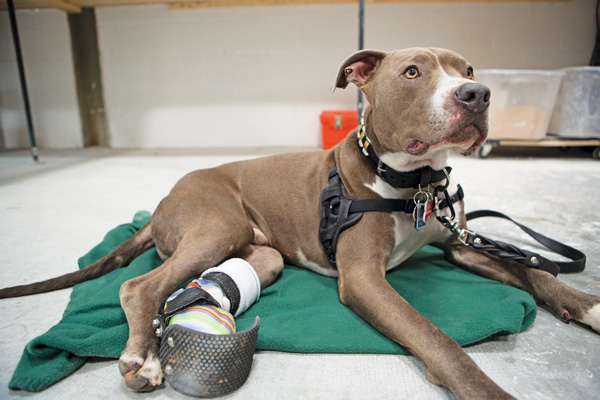
While surgeries can start between $2,000 and $5,000, braces and prosthetics cost about $550 and $1,000 respectively, and braces can help an animal heal without the need for surgery.
“This is the best job in the world,” Derrick says. “My goal is to treat as many animals as possible. We can help our pets live better lives through braces and prosthetics.”
A pet owner himself, he and his family are now looking to adopt a dog in need of a prosthesis. Certainly, there are some sad stories—he’s treated dogs rescued from Cambodia’s meat industry and a puppy that had its foot severed and leg nailed to a railroad track. Derrick created a prosthetic paw for the Pit Bull pup, named Hudson by his new owner, that replaced his missing foot and did not affect his other legs.
Hudson the railroad puppy went on to become certified as a therapy dog, and today spends his time visiting hospitals and other care facilities with his owner.
The happy endings more than make up for the sad ones. “I get to turn injured pets into bionic pets. I get to see an animal, born with a missing foot, walk for the first time. I get to see animals walk again that were injured. It can’t get better than that. I have pet owners cry all the time, happy that their family members are being treated.”
He feels that even the animals are appreciative. “Even though they can’t speak, I can tell by the way they wag their tails and from their overall demeanor,” he says.
“It’s amazing. I want to do this for the rest of my life.”
Join the newsletter and never miss out on dog content again!
"*" indicates required fields
By clicking the arrow, you agree to our web Terms of Use and Privacy & Cookie Policy. Easy unsubscribe links are provided in every email.